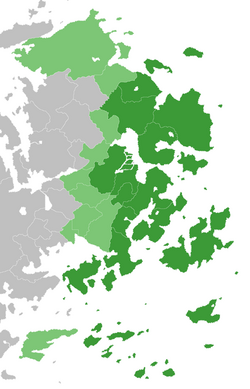Orient
 | |
| Demonym | Oriental |
|---|---|
| Countries | List of countries |
| Languages | List of languages |
The Orient is a prominent subcontinent within the larger landmass in the eastern portion of Europa. Historically and economically, this region has been a nexus for trade activities, serving as a conduit for exchanges between the continental nations of Eurth and various island chains, commonly referred to as archipelagos. The Orient's strategic positioning and rich resources have made it a focal point for commerce, fostering relationships and cultural exchanges between neighbouring territories.
Etymology
The term “Orient” traces its roots back to the word oriens, used by the Aroman Empire. In Aroman, oriens means “rising” or “to rise”, aptly referring to the region from which the San emerges. This nomenclature has led some scholars to speculate a potential association between the name “Orient” and the ancient country of Orioni. Historically, inhabitants of Orioni were at times referred to as Orionids, though this connection remains a matter of scholarly debate and further research.[citation needed] Delving deeper into linguistic origins, the term for "morning” in Proto-Europan might have been represented as āmrei or āmros.[1] Furthermore, the Oharic language has a synonym for morning, t’ewati, which aligns with the same theme of sunrise and new beginnings.
Geography
Situated in the eastern part of Europa, the Orient stands as a prominent subcontinent, distinguished by its array of diverse nations. Geographically, its boundaries extend to meet other significant regions. To the north, it shares its borders with the subcontinent of Burania, while Amutia lies to the west. To the southwest, one can find Azania. Additionally, the Orient encompasses the northeastern islands of Marenesia, contributing to its diverse ecological and geographical profile.
The majestic Khar Mountains demarcate the northern frontier between the Orient and its neighbouring subcontinent, Burania. Among these mountain ranges, there exists a notable pass, also named Khar Khaalga, which serves as a vital transit point through the rugged terrain. This pass holds significance, both geographically and historically, as it acts as a natural conduit between the regions.
Countries
The classification of countries within the Orient can vary based on the specificity of the definition applied. Considering a more traditional or strict interpretation, the primary territories of the Oriental subcontinent consist of the following sovereign states:
However, when employing a more expansive perspective, the boundaries of the Orient are seen to encompass additional countries. Some of these, due to their geographical and cultural affiliations, might be associated with other regions, yet they hold a significant connection to the Orient:
History
The history of the Orient encompasses a range of diverse civilisations, complex power struggles, and rich cultural interactions.
In the northern reaches of the Orient, history chronicles the defence against invasions from the neighbouring Buran people. Strategically, mercenaries played a pivotal role in this defence. In acknowledgment of their services, these mercenaries were permitted to settle in the mountain passes, which provided them both strategic and residential advantage. This led to the rise of significant regions within the Orient, notably Qardania and Karthenia. Etymologically, the name “Karthenia” draws from the terms Qara, meaning “black”, and Dan, which translates to “valley” or is reminiscent of the “Dane” people.
To the east, the annals of time emphasize the significance of the Golden River civilisation, which evolved around the rivers of Jaihu and Koku. These regions are among the most ancient civilisations. Their history is marked by cyclical patterns of fragmentation followed by periods of consolidation, reflecting the broader historical patterns observed in regions analogous to our East Asia and South Asia.
The southern narrative of the Orient is dominated by the archipelago civilisations, such as Orioni and Safiloa. These regions were hubs of trade, especially noted for the renowned Pearl Road trade system. The annals of Tamurin recount the saga of an ancient seafaring civilisation with sprawling port cities and intricate temple architecture. In the aftermath of the 11th-century conquest, Tamurin saw an influx of northern nobles. These leaders, with their distinct cultural and governance style, left an indelible mark on Tamurin's socio-political landscape. As time passed, an amalgamation of the native Tamurin traditions with the governance style of these northern leaders gave rise to a unique and vibrant culture. The lands of Mekabiri have been the cradle of ancient empires, renowned for their architectural marvels, expansive libraries, and centres of learning. Historically, Mekabiri has played the role of a cultural bridge, linking the narratives of the eastern and western regions of the Orient. Its history is marked by enlightened rulers, poetic expressions, and a spirit of inquiry, making it a focal point of trade, diplomacy, and cultural exchange in the Orient.
The western territories, particularly the Shakyan principalities, maintained intimate ties with Amutia. Key regions in this narrative include Youtabonia and the Mirian Republic, located to the north of a significant river. South of this river, the Koliyan clans thrived, specifically in the modern-day territories of Kotowari and Sarvoski. The region of Kotowari is notable for its rich deltaic landscapes and has a history steeped in maritime trade, riverine culture, and diverse ethnic groups. Over the centuries, Kotowari experienced frequent flooding, leading to an adaptive and resilient population that thrived on its fertile lands. Diplomatic relations were often cemented through marital alliances; notable instances include the marriage of Koliyan princesses to the Shakyan chieftains.



